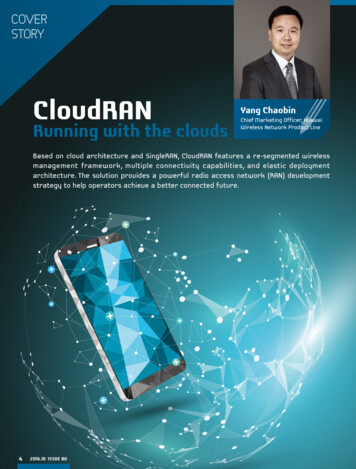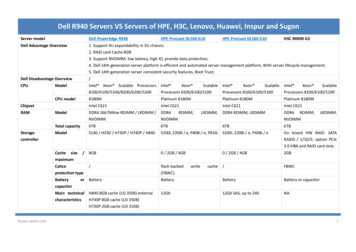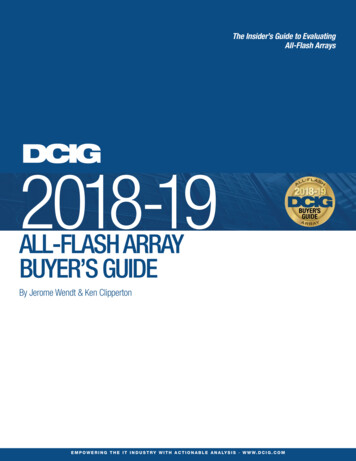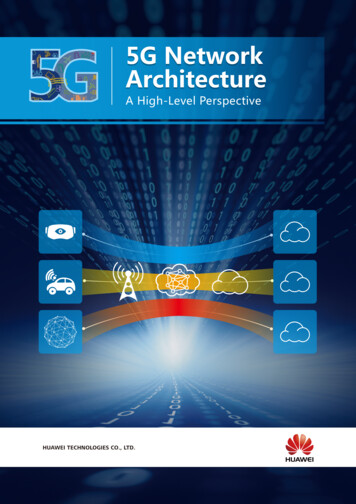
Transcription
COVERSTORYCloudRANRunning with the cloudsYang ChaobinChief Marketing Officer, HuaweiWireless Network Product LineBased on cloud architecture and SingleRAN, CloudRAN features a re-segmented wirelessmanagement framework, multiple connectivity capabilities, and elastic deploymentarchitecture. The solution provides a powerful radio access network (RAN) developmentstrategy to help operators achieve a better connected future.42016.10 ISSUE 80
CloudRAN: Running with the clouds / Cover StoryThe rise of mobile Internet hasnetwork management, basebands, andunleashed new types of servicesmaster control. The SingleRAN solutioncarried on public mobile networkssignificantly reduced RAN investment andthat would have once beenmaintenance costs, becoming the wirelessregarded as impossible. These include HDindustry's de facto standard architecture.video, virtual reality (VR), augmented reality(AR), driverless vehicles, real-time industrialSingleRAN is one of Huawei Wireless' mostcontrol, ubiquitous access to high-speedimpressive achievements in the past tencloud content anytime, Internet of Thingsyears. But, for the future, how will Huaweiservices, and public safety services – all areWireless meet the challenges to come?confirmed as key future wireless networkapplications. As network capabilities areThe next decade will see great changesopened and mobile edge computing (MEC)in wireless communications. 4.5G, 5G andgoes mainstream, the number of innovativenew forms of network construction andmobile Internet business models will increase.mobile applications will revolutionize mobileconnectivity. But, evolution from 4G to 5G aloneOver the next two to three years, mobilewill not prompt transformation. Far from it.network operators' most pressing issues willbe maximizing the value of mobile networks,Reconstructing basic interconnectivityconstructing future-facing mobile accesscapabilities as part of carriers’ digitalnetworks, and future service innovation. Newtransformation will increase in prominence,wireless architecture will need to connectbecause it will kick off a new stage of serviceeverything and adapt to an uncertain future.interconnections and open reconstruction. In theEvolve to adaptOver the nexttwo to threeyears, mobilenetworkoperators'most pressingissues will bemaximizing thevalue of mobilenetworks,constructingfuture-facingmobile accessnetworks, andfuture serviceinnovation.future, new network architecture will be neededto meet a multitude of new requirements likenetwork flexibility. These requirements willRAN architecture has evolved over twocome from diverse services, new businessstages. In the era of traditional RANs – themodels, and the need for faster connections andfirst stage – operators built networks usinganytime, ubiquitous, and consistent experiencesdifferent technologies based on independenton complex multi-band, multi-standarddesigns, hardware components, andheterogeneous networks.operating teams. They were expensive andflexibility was poor. Huawei's SingleRANWith this uncertainty, Huawei Wirelesssolution in 2007 marked the start ofhas upped its game since SingleRAN withthe second stage: SingleRAN enabled theCloudRAN, its latest breakthrough in wirelessintegrated deployment of the followingcommunications networking.standards: GSM, WCDMA, CDMA2000, andLTE. This was completed on a single accessplatform that used the same hardwareCloud tech on mobilearchitecturecomponents, spectrum, transmission,2016.10 ISSUE 805
COVER STORYSix distinctive features of CloudRAN dconnectivity3ElasticnetworksAdopting a cloud-based hardware andC l o u d R A N i nte g r ate s a l l a c c e s sCloudRAN's new network layeringUnleashEnablesoftware system, CloudRAN includes a Unleash thetechnologieson to thea single platform,Build an agilestandard means thesystem is ries of systematic cloudi capabilitiesincluding 4G, 4.5G, and future 5Gto functions rathercarriers'than mationlike functions virtualization, resourcetechnology, and various non-licensedelements. This allows flexible, fast,provide theof theand buildthecloudification, distributed architecture,spectrummigrationaccess technologiessuch to address and elastic iversenext-generationlayered capabilities , and flexibleas Wi-Fi.based on service developmentexperienceto the s.scenariossystemsCloudRAN is designed to helpdifficult part to cloudify, putting thealso be applied to terminals for theoperators deal with the complexitylast piece of the puzzle in place foroptimum user experience.of tomorrow's tech integration,full cloudification – an unprecedentedservice diversification, and businessinnovation in wireless infrastructure.multiple connectivity are the future.model fragmentation. Featuringredesigned wireless managementCloudRAN transforms the RAN andMainstream mobile terminals arearchitecture and capabilities likedelivers cloud capabilities like functionscapable of multi-standards access,resource management, multi-virtualization, resource cloudification,but only in a single connectivity state.tech connectivity, and elasticarchitecture distribution, capabilitiesBut, spurred by the industry, multiple-architecture, carriers can betterlayerization, and flexible coordination.connectivity will happen. CloudRANcope with future uncertainties.The solution enables hardwareconsolidates all access technologiesCloud-based architectureresource pooling to maximize resourceon a single platform; the completedsharing. With fully distributedstandards include TDD and FDD LTE dualWith cloud-based hardware andsoftware architecture resemblingconnectivity and LTE Wi-Fi aggregation.software systems, CloudRAN enablesthose of Internet companies, CloudRANoperators to build a service-drivengives elastic capabilities such asThe new architecture will be able toand user-centric elastic networkflexible fault handling and resourceconnect to multiple types of accessthat supports 4G and 5G connectivityscheduling, and fully automatestechnologies, including traditionaland embraces the diversity of futureservice deployment, resource4G, 4.5G, and future 5G technology,MBB and services for verticals.scheduling, and troubleshooting.and various non-licensed spectrumMulti-standard connectivityaccess technologies such as Wi-Fi.future networking. Huawei's All CloudCloudRAN architecture adoptsCloudRAN architecture overcomesstrategy sets out a blueprint for fullmulti-connectivity technology toanchor point selection with multiple-E2E network cloudification. Huawei'sovercome the complexity of a multi-connectivity technology. The anchorCloudRAN fully integrates cloudstandard, multi-band, and multi-point enables service distribution,concepts into the RAN, the mostlayer integration environment. It cancarries out unified management, andCloud architecture is the basis of6The industry agrees that 5G and LTE2016.10 ISSUE 80
CloudRAN: Running with the clouds / Cover Story4General virtualizedcontainersCloudRAN features the new functionelement Mobile Cloud Engine to handlethe physical deployment location ofresource management and schedulingand provide loading and managementfor the E2E slicing functionalityof 5G.5CapabilityopeningWith CloudRAN, the network capabilitiesof wireless base stations can be moreeasily opened through virtualizedcontainers. CloudRAN's capability openingfunction will continue to evolve fromsimple APIs to complex APIs. Thiswill be scenario-based andInternetized.allocates high-level data, which isoptimal collaboration efficiency andrestored on the terminal via differentfast and elastic function deployment toair interface technology pipes. Thisreflect service growth requirements.enables operators to maximize theuse of technology, spectrum, andBase station atomization considershardware resources to increasethe benefits as well as the technicaloverall resource efficiency.costs. Dividing the horizontal layerElastic networksof base stations into real-time andLike the early distributed base stationsystem to better adapt to diversedesign, CloudRAN balances distributionnetwork environments and implementand centralization through a new,multiple connectivity, multi-carrier,layered framework. All networkand multi-streaming technologies.functions can be configured andIn principle, real-time componentsmanaged on-demand to deal withare closer to base stations, enablingbusiness model fragmentation andsuper-low latency and acceleratingservice growth in verticals.post-processing on complex datanon-real-time sections will enable the6Mobile edgecomputingCloudRAN enables the flexible deploymentof core network gateways, servicegateways, cache servers, and applicationservers based on scenarios, allowingservice development to be closer tobase stations and users, whichenables mobile edgecomputing.Like the earlydistributed basestation design,CloudRAN balancesdistribution andcentralizationthrough anew, layeredframework.calculations at the front end.CloudRAN's new network-layeringstandard means the system is function-Centralizing non-real-timeoriented rather than based on networkcomponents can support multi-elements. Resource managementdimensional wireless standardadds more detailed functions to themanagement and servicetraditional vertically managed wirelessdistribution unification. With elasticarchitecture systems. These capabilitiesarchitecture, real-time and non-real-can be configured on-demand andtime scheduling on different layersnetwork functions atomization forenables transition from network-2016.10 ISSUE 807
COVER STORYCloudRANarchitecturecan be usedin differentwirelessnetworkenvironmentsand scenariosto deal withdifferentuncertainties.centric to service-centric deployment.by OTT companies and verticals to innovateGeneral virtualized container designservices.CloudRAN will open management capabilitiesCloudRAN's capability opening function willto better serve verticals. Huawei haskeep evolving from simple to complex APIsincluded its Mobile Cloud Engine into theand into scenario-based and Internetizednew architecture to configure wherecapabilities, helping operators to furtherresource management and scheduling areexpand individual and household markets,physically located and to provide loading andtraditional enterprises, vertical industries,management on E2E slicing for 5G by openingand Internet markets. Operators can thencapabilities and resource management.expand and succeed in the digital economy.Mobile Cloud Engine is an optimized virtualEnabling mobile edge computingmachine for wireless capabilities that canCloudRAN allows core network gateways,run on dedicated platforms and generalservice gateways, cache servers, andcommercial-off-the-shelf (COTS) platforms withapplication servers to be flexibly deployedCloud OS under a COTS cloud infrastructure.based on scenario, allowing serviceIt offers carrier-class disaster recovery anddevelopment to be closer to base stationson-demand deployment, flexible capacityand users. This will also enable MEC,expansion, independent feature upgrades, andfunctions like reducing transmission distanceother functions of native cloud architecture.and latency, and optimization processing.Opening capabilities: A hotbed ofservice innovationEach function component can share computingCommunications networks must be able todevelopment costs and greatly increasing MECopen network capabilities. Thus, operatorsinnovation. Running services as close to endneed to get involved in the Internetusers as possible slashes latency, enabling rapidindustry chain, and by monetizing networkfeedback on network status and lesseningcapabilities, transform towards bilateralcongestion on the rest of the network. Tighterbusiness models. If RANs are closer to users,integration with wireless components enablesnetwork information is more accurate.CloudRAN to acquire information on traffic,Opening RAN capabilities can bring morewireless, and terminal device location morebusiness value for operators. CloudRANeasily, which in turn allows big data analysis andarchitecture opens wireless base stationnew business models.network capabilities through virtualizedcontainers, including anonymized userand storage resources, lowering serviceBenefits for verticalslocations, network optimization parameters,82016.10 ISSUE 80QoS, billing, users' context networkCloudRAN architecture can be used in differentinformation, and service APIs. These valuablewireless network environments and scenariosdata sources and interfaces can be usedto deal with different kinds of uncertainty
CloudRAN: Running with the clouds / Cover Storythat will occur in future as wirelesscollaboration and significantly improvesto service type. For example, videonetworks evolve. This will enablecell edge user rates, thus guaranteeingservices can be deployed closerwireless networks to become the coreuser experience. CloudRAN alsoto the end user to reduce theinfrastructure and key innovationsupports the automatic selection oftransmission resources needed bydriver of socioeconomic development.different collaboration levels accordingthe system, shortening latency andSharing network resourcesto deployment conditions to maximizeensuring an optimal user experience.the value of operator assets.Two issues are that differentCloudRAN architecture also allowsoperators offer a wide variety ofThese functions greatly increasedevelopers to fully leverage thenetwork transmission resources andspectral usage efficiency.value of network capabilitiesfiber-to-the site rates differ fromUltimate experiences withultra-broadbandthrough opening networkresources requires resource sharing,CloudRAN's multiple concurrentcommercial value and serviceincluding baseband resources andconnections capability allows usersinnovation; for example, anonymizedcomputing and storage. CloudRAN
(AR), driverless vehicles, real-time industrial control, ubiquitous access to high-speed cloud content anytime, Internet of Things services, and public safety services – all are confirmed as key future wireless network applications. As network capabilities are opened and mobile edge computing (MEC) goes mainstream, the number of innovative mobile Internet business models will increase. Over .











